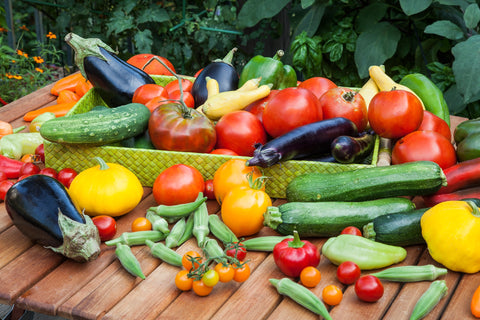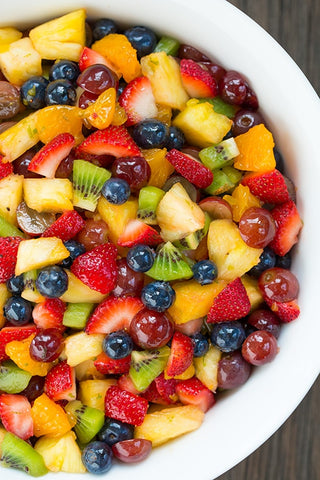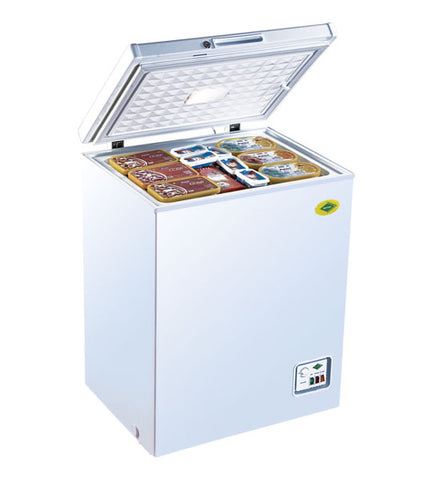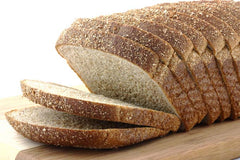There are so many reasons to fill your freezer with food for your family. Maybe there is a great sale on hamburger. Maybe you've raised a hog to feed your family. Your garden had an abundance of produce and some things your family prefers frozen over canned. What ever the reason you are filling your freezer there are safety guidelines to follow. Let's dig right in!

You can freeze just about anything using the right techniques. Canned foods ( still in the can) and eggs still in the shell are exceptions. There are some things that just don't hold up well to freezing like lettuces and mayonnaise. Moisture is the biggest issue with freezing foods.
The preferred temperature for storing frozen foods is 0 degrees Farenheit. Most food stores carry thermometers that go in a refrigerator or freezer to help monitor temperature.
How does freezing keep food safe? It prevents the growth of microorganisms which cause food to spoil and bacteria to grow. The longer food is stored the more the quality deteriorates. Even though 0 degrees Farenheit inactivates bacteria, yeasts and molds these organisms can be active once foods are thawed.
When foods go into the freezer have a big impact on how good they are when you take them out to use them. Foods frozen at their peak quality will be far better then those frozen just before they "go bad". Freezing doesn't alter the nutritional value of foods.

Enzyme activity is another issue though. It can cause deterioration of foods. Enzymes cause ripening. Freezing slows this enzyme activity but doesn't stop it.
Frozen fruits have acids that keep the enzyme activity in check. Meats and fish aren't affected by enzymes. Vegetables however are different since they are low in acid but they do freeze well. Blanching is a process to partially cook the vegetables then quickly cooled to stop the cooking. This helps prevent deterioration.

What kind of packaging is best? Vacuum sealing is king when it comes to freezing food. It removes moisture which is the biggest cause of freezer burn. You can throw foods in the freezer right from the market in the original packaging. As with any food going in the freezer write the date on the package with a permanent marker. You will want to use the foods in their original packaging first because the thinner wrapping will allow air in which dries foods out and causes the infamous freezer burn. Freezer burn doesn't make food unsafe. If there is a lot of freezer burn it may affect the quality and therefore the taste.
When freezing foods it's best to freeze them quickly. If you are freezing many packages you can spread them out in a single layer if possible. Avoid stacking several unfrozen packages that will slow the rate of freezing. Small fruits are easy to freeze on a cookie sheet then put them in a bag. Then you can grab a handful at a time instead of having to thaw the entire package. On the subject of packaging it's helpful to use packaging that is right for a single recipe or serving.
Here's a guide for How Long To Store Frozen Food
| Food | How Long |
| Bacon and Sausage | 1 to 2 months |
| Casseroles/Lasagnas | 2 to 3 months |
| Frozen Dinners/Entrees | 3 to 4 months |
| Gravy/Soups/Stews | 2 to 3 months |
| Ham/Hotdogs/Luncheon Meats | 1 to 2 months |
| Meat, uncooked roasts | 4 to 12 months |
| Meat, uncooked ground | 3 to 4 months |
| Meat, cooked | 2 to 3 months |
| Poultry, uncooked whole | 12 months |
| Poultry, uncooked parts | 9 months |
| Poultry, cooked | 4 months |
| Wild Game uncooked | 8 to 12 months |
| Dairy Products | 3 months |
| Source: USDA |
For baked goods, dairy, vegetables and fruits quality of the item when it is thawed will determine if it's usable.

Foods you may not have thought to freeze:
- Breads, rolls, wraps
- Butter
- Yogurt- dispense into ice cube trays or small containers. Best used in smoothies
- Cheese
- Milk ( remove about 1.5 cups to leave room for expansion)
Now you have a freezer full of plenty of ingredients to use but how to thaw them safely? It depends on how much time you have. The safest way, particularly for meats is in the fridge. How long this takes depends the size of the package. Steaks, hamburger, bacon and such can be taken out the say before, placed on a plate or in a container to catch any dripping juices and put in the refrigerator to thaw over night. If you forgot and need to do a quick thaw place the package in a pot of cold water- not hot, and it will be ready to use in less than an hour, depending on the thickness. Another alternative if you really don't have time is to use your microwave's defrost mode. Don't use the HIGH setting as it will begin to cook the food on the outside but still be frozen on the inside.
Bigger items such as turkey's can take up to 3 days to thaw and should definitely be put in the refrigerator. Even if it is cold outside don't try to thaw a turkey or chicken because temperature fluctuations can lead to contamination.
Can you refreeze something once it's thawed? Yes as long as it has been stored properly. The quality may not be as good but will be safe.
What if there is a power outage? The worst thing you can do is keep opening the door to "check the temperature". The more the door stays closed the more the temperature will stay cold. A freezer that is full can and looses power can keep food safe for 2 days. A freezer that is not full may take a little rearranging. Meats should be placed in trash bags to contain juices if they begin to thaw. Ice bags or better yet, ice blocks can help keep temperatures up.
Ice crystals aren't an issue for safety just may affect quality.
Discard foods that have been at 40 degrees Farenheit for more then 2 hours.
Discards foods that have been exposed to meat juices.
Discard ice cream that is crystallized.
